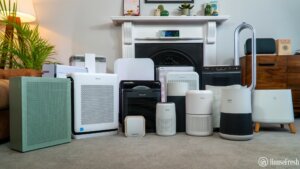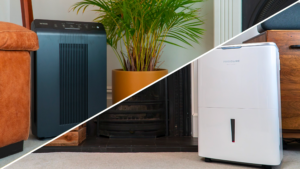Have you ever been in a crowded room or office and suddenly felt drowsy — although you entered it wide awake only an hour or two earlier?
Then, when you step outside, you notice how stuffy and stale that place was compared to the outdoors. You’re revived instantly, too, by the fresher air.
If you’ve ever experienced this, stale air is to blame. But you realize it only after leaving the stuffy room or office.
In this article, you’ll learn about the causes and effects of stale air.
Fortunately, stale or stuffy air in your home or office is an easily solvable problem. You’ll discover here how to remedy the situation quickly, and keep it under control.
Carbon dioxide: Source of stale air
The reason why indoor air is stale is the presence of elevated levels of carbon dioxide (CO2). Even moderate amounts of CO2, typical in homes and offices today, could lead to stale and stuffy air.
Gaseous carbon dioxide is naturally present in the atmosphere in a very small amount (compared to oxygen and nitrogen): only 0.04%.
Before the Industrial Age got underway in the late 1700s with the invention of the coal-powered steam engine, the amount of carbon dioxide in the atmosphere was approximately 288 parts per million (ppm).
Due to the ever-increasing amount of fossil fuel burning for transportation, home heating, and manufacturing, especially in the United States and China, there is even more CO2 in the air.
Today, it stands at approximately 422 ppm. Experts predict that if the combustion of fossil fuels continues at today’s pace, CO2 levels could get to 550 ppm by 2050 and over 900 ppm by 2100.
In response to the increasing levels of atmospheric CO2 and other heat-trapping gases, the world is experiencing a climate crisis with no end in sight: intensifying weather events such as massive floods, extreme drought, and wildfires.
From this observation, it’s clear that carbon dioxide at high concentrations is a pollutant.
Just as a high concentration of carbon dioxide is a pollutant outdoors, it can be a pollutant in your home when it’s present at certain levels. When it is moderately elevated, the air is called stuffy or stale. When it is very elevated, the air is suffocating.
If you’ve been in a moderately stuffy room for more than a few hours, you may not realize it. You become habituated to it — although you may begin to feel tired and lethargic. Maybe you notice your thinking isn’t as sharp as it was before entering the room. But once you leave the stuffy room, you’ll notice the difference in air quality almost immediately. Likewise, you feel better and can think more clearly.
Odorless carbon dioxide builds up in your home or office making the indoor air stale when one or more of the following conditions occurs:
– There are many people in a confined space for a long time.
– The enclosed area is constructed of materials that are tightly sealed with no cracks or crevices for outside air to seep in.
– There is insufficient or a total lack of natural or mechanical ventilation.
A roomful of people generates carbon dioxide through breathing. The gas is a waste product of normal cell functions like growth and replication. The human body gets rid of it through exhalation via the lungs. According to the Environmental Safety and Health Group (ESHG) of the United States Department of Agriculture, (USDA), moderate indoor levels of carbon dioxide cause drowsiness and headaches.
Higher indoor levels may result in:
1. Light-headedness
2. Rapid breathing
3. Brain fog
4. Increased cardiac output
5. Heightened blood pressure
6. Heart arrhythmias
7. Nausea
8. Vomiting
9. Extremely high levels of indoor CO2 could result in loss of consciousness or death by suffocation
What is an acceptable indoor level of carbon dioxide?
The United States Environmental Protection Agency (EPA) uses the 2001 American Society of Heating, Refrigerating and Air-Conditioning Engineers (ASHRAE) standard of 700 ppm above the outdoor level of carbon dioxide as an acceptable indoor level of CO2.
Today, with ambient CO2 at 422 ppm, that means 1,122 ppm (700 + 422) indoors is acceptable according to the EPA.
EPA points out “…the recommended ASHRAE standard of 700 ppm above the outdoor concentration is to prevent body odor levels from being offensive.”
Several countries have adopted other standards for acceptable levels of CO2. Some are more stringent than others. Table C1 in a 2020 Canadian document titled Residential Indoor Air Quality Guidelines for Carbon Dioxide provides a detailed summary.
From Table C1, the European Union has the most specific guidelines on carbon dioxide, offering four ratings of air quality. [NOTE: The outdoor level is approximately 422 ppm today.]
| Carbon Dioxide (ppm) | Air Quality Rating |
|---|---|
| <400 above outdoor level | Excellent |
| 400-600 above outdoor level | Average |
| 600-1,000 above outdoor level | Moderate |
| >1,000 above outdoor level | Low |
To place these numbers in perspective:
- The Environmental Safety and Health Group (ESHG) of the USDA reports that 900 ppm of carbon dioxide is common in urban areas.
- Inside Canadian homes, numerous instances of 800-1,500 ppm of CO2 have been reported.
What are the health effects of carbon dioxide exposure?
There is a growing body of scientific data on the health effects of carbon dioxide (CO2). This research is ongoing partly in response to four modern-day phenomena:
- Increasing atmospheric levels of CO2 from fossil fuel burning
- Majority of time (90%+) people spend indoors
- Tightly sealed buildings preventing outdoor air exchange
- More exposure to greater numbers of people in enclosed places.
Both human and animal studies on the health effects of chronic and acute carbon dioxide exposure show similar adverse consequences even at levels as low as 1,000 ppm. This value is common indoors. Many national standards of acceptable levels are at or above 1,000 ppm.
Based on human studies, acute exposure to carbon dioxide leads to:
| Adverse Health Outcome | CO2 Level (ppm) | Exposure Duration (hrs.) |
| CO2 retention* (hypercapnia or hypercarbia) | 1,000+ | <4 |
| Inflammation | 2,000+ | 2 |
| Cognitive Effects | 1,000+ | 1 |
*Lowers blood pH, possibly leading to respiratory acidosis.
From human studies, chronic exposure to carbon dioxide leads to:
| Adverse Health Outcome | CO2 Level (ppm) | Exposure Duration (days) |
| Systemic Inflammation | 3,000 | 13 |
| Bone Demineralization | 2,000+ | 60+ |
| Kidney Calcification | 2,000+ | 60+ |
| Behavioral Changes | 700+ | 13+ |
| Oxidative Stress | 3,000+ | 13+ |
To place these numbers in perspective:
- Multiple studies report classroom levels that regularly exceed 2,000 ppm CO2 with peak concentrations ranging between 3,000-6,000 ppm. Natural v. mechanical ventilation caused no significant difference in peak levels.
- Bedrooms can easily exceed 2,500 ppm after a full night of sleeping when doors and windows are closed and mechanical ventilation is reduced. A CO2 concentration of 1,000 ppm is common 50% of the time during the night with doors and windows closed but normal mechanical ventilation rates.
What are acceptable airflow rates for indoor places to maintain good indoor air quality including carbon dioxide levels?

The American Society of Heating, Refrigerating and Air-Conditioning Engineers, (ASHRAE), in conjunction with the American National Standards Institute, (ANSI), publishes a document titled Ventilation for Acceptable Indoor Air Quality commonly referred to as ANSI/ASHRAE Standards 62.1 and 62.2.
This document, most recently revised and expanded in 2019, is based on the assumption that when indoor ventilation — either mechanical or natural or both — is adequate, indoor air quality will be acceptable. This includes carbon dioxide levels.
Table 6.1 of ANSI/ASHRAE Standard 62.1-2019 lists appropriate levels of outdoor airflow per person into hundreds of indoor settings such as schools, restaurants, and hospitals. The airflow rate is stated in cubic feet per minute (cfm).
When the airflow rate is at or above these levels for various spaces — and the occupant density is under the stated levels — the indoor air quality (IAQ) is considered good (microbial contaminants not considered).
Although ASHRAE did not include a private home as a separate category, they advise using the category most similar to it for guidance on acceptable airflow rates as a measure of good IAQ. So, hotel rooms are included as representing rooms in private homes, and a restaurant kitchen as a home kitchen.
| Place | Airflow per person (cfm) | Airflow per area (cfm/ft.2) | Person density (#/1,000 ft.2 ) |
|---|---|---|---|
| Bedroom/Liv-ing room (Hotel) | 5 | 0.03 | 10 |
| Kitchen (cooking) | 7.5 | 0.6 | 20 |
| Classroom | 10 | 0.12 | 30 |
| Restaurant | 7.5 | 0.9 | 70 |
| Office | 5 | 0.06 | 5 |
| Supermarket | 7.5 | 0.06 | 8 |
| Health Club | 20 | 0.3 | 25 |
In order to ensure these airflow rates (or better) in various indoor spaces that indicate good IAQ, it’s important to open windows (when outdoor air quality is good) or make sure your HVAC is up to speed (literally). If you don’t have sufficient ventilation with open windows, use fans to improve your room airflow rate.
When you do, you’ll no longer have stale air problems in your home or office according to ASHRAE.
Common questions about stale and stuffy Air
ANSI/ASHRAE standards serve as helpful guidelines for good indoor air quality (IAQ) when it comes to common air contaminants such as carbon dioxide. There are other measures you can take as added security to avoid stale air in your home or office. Carbon dioxide monitors and regularly opening windows top the list.
A carbon dioxide monitor may provide you with a good estimation of how good your indoor air quality (IAQ) is — but only if CO2 is the indoor air problem you have. Unfortunately, there are other airborne contaminants in your home or office not detected by the monitor including particle pollution and volatile organic compounds (VOCs). These reduce your IAQ.
Furthermore, it’s likely that your monitor reading could mislead you into believing that you have adequate ventilation. This is due to the fact that ASHRAE standards are based on a steady state between CO2 levels and the ventilation rates as given in the table above. This state is achieved only when the same number of people remain in an enclosed area for a long period of time.
In other words, especially when measurements are first taken, the CO2 level will be low, suggesting ventilation rates are adequate. This may or may not be true.
Key takeaways on stale air and how to fix It
- Stale air in homes and offices is caused by elevated levels of carbon dioxide.
- A large number of standards from around the world suggest that 1,000 ppm is the upper limit for an acceptable indoor level of CO2.
- With atmospheric CO2 on the rise and most people spending 90%+ of their time indoors with little or no ventilation, sometimes in large groups, levels can easily reach 2,000+ ppm for extended periods.
- Chronic and acute exposures to carbon dioxide at or above 1,000 ppm lead to many negative health outcomes including cognitive deficiencies, bone demineralization, or kidney calcification.
- Increasing ventilation is important in controlling carbon dioxide levels indoors assuming outdoor air quality is good.






